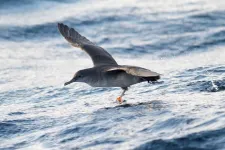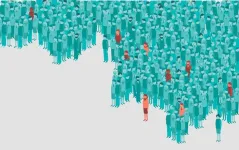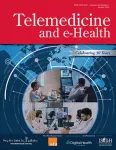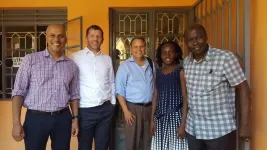(Press-News.org) EMBARGOED UNTIL MONDAY, 29 JANUARY 2024, 21:00 CET (20:00 LONDON TIME, 15:00 U.S. EASTERN TIME)
Have you ever seen a hummingbird hawk moth? When people encounter this moth for the first time, they are usually intrigued: Looking like a cross between a butterfly and a bird – hence the name – this animal has the amazing ability to hover like a helicopter for long periods. On closer inspection, another feature of the hummingbird hawk moth quickly catches the eye: the spiralling curled proboscis, which is as long as the entire animal.
The moth uses its proboscis to suck nectar by inserting it through a tiny opening into the floral nectaries, seemingly effortlessly and in a matter of seconds. "It's like trying to hit the opening of a drink can with a two metres long straw in your mouth", says Anna Stöckl, a biologist at the University of Konstanz. In a recent study in the journal PNAS, she and her colleagues investigated the sensory information the moths rely on to precisely control their proboscis. They discovered that the animals use their sense of sight to move and, if necessary, correct the movement of the proboscis using visual feedback on the way to the nectary, much like we humans do when grasping something with our hands. This complex form of appendage control was previously known mainly from animals with comparatively large brains, such as monkeys or birds.
Looking at the proboscis in "slow motion"
To demonstrate that this appendage control also occurs in insects, the researchers conducted sophisticated behavioural experiments in which hummingbird hawk moths were recorded with high-speed cameras as they approached artificial flowers. This way they could determine the exact positions of the moths' bodies, heads and proboscis with high temporal resolution while the animals were searching for nectar. It is known that hummingbird hawk moths use visible patterns on the flowers, which they scan with their proboscis to get to the sugary liquid faster.
The movement analysis initially revealed that hummingbird hawk moths can only move their proboscis forwards and backwards by about one and a half centimetres, and can hardly move it sideways at all. To control the rough positioning of the proboscis in the flower, the animals move their entire bodies in flight, while the smaller movements of the proboscis itself are used to precisely target the flower pattern. "It's very similar to our fingers, which, apart from the thumb, we can mainly move forwards and backwards. Nevertheless, we can perform very complex movement patterns by also moving our hands for rough directional control – for example when playing the piano", explains Stöckl.
Insect brains are masters of efficiency
There is another similarity to humans: hummingbird hawk moths need continuous visual information to manoeuvre their proboscis precisely to the nectary, just like we humans have to keep our eyes on our fingers to direct them towards a target when performing untrained hand movements. If the moths' eyes were covered so they could not see their proboscis, they could still touch the flower. However, they no longer scanned their proboscis along the flower patterns, but instead scanned randomly, which can prolong the search for nectar.
The fact that the moths use visual feedback for the fine control of their proboscis was somewhat surprising, because such a real-time coordination between what they see and the movement of their proboscis is computationally complex. Insects have a comparatively simple nervous system with less than one million nerve cells, compared to nearly 90 billion in the human brain. "To complete this task, the insects have only a tiny fraction of the processing capacity of our human nervous system", says Stöckl. That is exactly what makes them so interesting as a model organism for research into the visual control of appendages. "And that is not all! These small brains and their efficient way of working are also great models for applied research, for example in robotics. We can learn a lot from hummingbird hawk moths", Stöckl points out.
Key facts:
EMBARGOED UNTIL MONDAY, 29 JANUARY 2024, 21:00 CET (20:00 LONDON TIME, 15:00 U.S. EASTERN TIME)
Original publication: S. Kannegieser, N. Kraft, A. Haan & A. Stöckl (2024) Visual guidance fine-tunes probing movements of an insect appendage. PNAS; doi: 10.1073/pnas.2306937121
Study proves limb control with the help of visual feedback in insects (hummingbird hawk moth; Macroglossum stellatarum)
Stöckl is a junior professor and the leader of an Emmy Noether research team at the University of Konstanz: https://www.insect-vision.com/
Stöckl regularly publishes her research for a wide audience. A selection of her work is available at: https://www.annastoeckl.com/science-communication
Open Science: The replication data for the study are available open access from Figshare; the associated analysis scripts can be downloaded from Github.
Note to editors:
You can download images and a video here:
Link: https://www.uni-konstanz.de/fileadmin/pi/fileserver/2024/den_ruessel/macroglossum.jpg
Caption: Hummingbird hawk moth (Macroglossum stellatarum) foraging in France (Sorède)
Image: © Anna Stöckl
Link: https://www.uni-konstanz.de/fileadmin/pi/fileserver/2024/den_ruessel/taubenschwaenzchen.jpg
Caption: Hummingbird hawk moth (Macroglossum stellatarum) foraging in France (Sorède)
Image: © Anna Stöckl
Link: https://www.uni-konstanz.de/fileadmin/pi/fileserver/2024/den_ruessel/track.jpg
Caption: Single frame of a high-speed video of the experiments. The positions of the animal's proboscis on the flower are marked in colour over a total duration of 30 seconds. Not visible due to the black and white images: presented was a yellow cross pattern on a blue background.
Image: © Stöckl Lab
Link: https://www.youtube.com/watch?v=oI3qyhuPfeY
Caption: Video of an experiment. Different body parts of a hummingbird hawk moth are tracked while the animal is searching for nectar in an artificial flower.
Video: © Stöckl Lab
END
A firm eye on the proboscis
Just as when we humans reach for objects, the hummingbird hawk moth uses its visual sense to place its long proboscis precisely on a flower to search for nectar, according to a study by Konstanz biologists.
2024-01-29
ELSE PRESS RELEASES FROM THIS DATE:
Viral protein fragments may unlock mystery behind serious COVID-19 outcomes
2024-01-29
There are many lingering mysteries from the COVID-19 pandemic. For instance, why does SARS-CoV-2, the virus behind the disease, cause severe symptoms in some patients, while many other coronaviruses don’t? And what causes strange symptoms to persist even after the infection has been cleared from a person’s system?
The world may now have the beginning of answers. In a study published today in the journal Proceedings of the National Academy of Sciences, a UCLA-led multidisciplinary research team explores one way that COVID-19 turns the ...
Endangered seabird shows surprising individual flexibility to adapt to climate change
2024-01-29
New research finds that individual behavioural flexibility and not evolutionary selection is driving the northward shift of Balearic shearwaters.
The findings were revealed through a decade-long study which tagged individual birds.
The results indicate that individual animals may have greater behavioural flexibility to respond to climate change impacts than previously thought.
How individual animals respond to climate change is key to whether populations will persist or go extinct. Many species are shifting their ranges as the environment warms, but up to now the mechanisms underlying ...
Spacing characteristics between vegetation could be a warning sign of degrading dryland ecosystems - study
2024-01-29
Scientists have found that the spatial arrangement of plants in drylands can be a sign of the environment degrading, according to a new study.
One of the iconic features of drylands is the striking appearance of islands of plants surrounded by bare soil. This spatial structure of arid vegetation has long fascinated scientists, but now a new study published in Proceedings of the National Academy of Sciences, has shed new light on why these plants group in this way.
An international team of scientists, including from the University of Birmingham, combined field data from 115 sites around the world, and used mathematical models and remote sensing to build a picture of how the ...
Researchers spying for signs of life among exoplanet atmospheres
2024-01-29
COLUMBUS, Ohio – The next generation of advanced telescopes could sharpen the hunt for potential extraterrestrial life by closely scrutinizing the atmospheres of nearby exoplanets, new research suggests.
The next generation of advanced telescopes could sharpen the hunt for potential extraterrestrial life by closely scrutinizing the atmospheres of nearby exoplanets, new research suggests.
Published recently in The Astronomical Journal, a new paper details how a team of astronomers from The Ohio State University examined upcoming telescopes’ ability to detect chemical ...
People are inclined to hide a contagious illness while around others, research shows
2024-01-29
A startling number of people conceal an infectious illness to avoid missing work, travel, or social events, new research at the University of Michigan suggests.
The findings are reported in Psychological Science, a journal of the Association for Psychological Science. Across a series of studies involving healthy and sick adults, 75% of the 4,110 participants said they had either hidden an infectious illness from others at least once or might do so in the future. Many participants reported boarding planes, going on dates, and engaging in other social interactions while secretly sick. More than 61% of healthcare workers participating in the study also ...
Racial and ethnic differences in hypertension-related telehealth
2024-01-29
A new study in the peer-reviewed journal Telemedicine and e-Health found that hypertension management via telehealth increased among Medicaid recipients regardless of race and ethnicity during the COVID-19 pandemic. Click here to read the article now.
Jun Soo Lee, PhD, from the Centers for Disease Control and Prevention (CDC), and coauthors, reported that from February-April 2023, the number of hypertension-related telehealth outpatient visits per 100 persons increased from 0.01 to 6.13, and the number of hypertension-related in-person visits decreased from 61.88 to 52.63.
The investigators ...
Henry Ford Health helps advance precision medicine research in Michigan
2024-01-29
Michiganders will continue to have the opportunity to advance medical research aimed at advancing individualized health care through a renewed award to Henry Ford Health + Michigan State University Health Sciences from the National Institutes of Health’s (NIH) All of Us Research Program. The award includes $18.3 million in initial funding to support a consortium of 8 health care provider organizations with a presence in 16 states.
Henry Ford has led the consortium since 2017. The renewed award allows participation to continue until at least 2028. The multimillion-dollar multi-year award represents the largest NIH research grant in Henry Ford’s 108-year history.
All ...
Jobs and geography may affect hearing: New study maps hearing loss by state and county across the US
2024-01-29
Chicago, IL – January 24, 2024 – The first study to map the prevalence of bilateral hearing loss in the United States by state and county finds that rates of hearing loss are higher among men, non-Hispanic Whites, and residents of rural areas. Bilateral hearing loss is hearing loss in both ears.
West Virginia, Alaska, Wyoming, Oklahoma, and Arizona had the highest rates of hearing loss, while the District of Columbia, New Jersey, New York, Maryland, and Connecticut had the lowest (see top ten highest and ...
UChicago engineer driving key role in Great Lakes water transformation
2024-01-29
The Chicago-based Great Lakes ReNEW coalition has been awarded one of the largest, if not the largest, climate awards in the city’s history – up to $160 million over 10 years as one of the inaugural U.S. National Science Foundation’s Regional Innovation Engines.
Authorized in the “CHIPS and Science Act of 2022,” the NSF Engines program is designed to support the development of diverse regional coalitions of universities, local governments, the private sector and nonprofits to create solutions to today’s pressing issues.
Selected from an initial pool of more ...
Hydroxyurea significantly reduces infections in children with sickle cell anemia
2024-01-29
INDIANAPOLIS -- Clinical research led by Indiana University School of Medicine investigators and their collaborators in Uganda has revealed that hydroxyurea significantly reduces infections in children with sickle cell anemia. Their latest findings enhance strong evidence of hydroxyurea’s effectiveness and could ultimately reduce death in children in Africa, the continent most burdened by the disease.
The group’s research, recently published in the journal Blood, revealed that hydroxyurea treatment resulted in a remarkable ...
LAST 30 PRESS RELEASES:
University of Oklahoma researcher awarded funding to pursue AI-powered material design
Exploring how the visual system recovers following injury
Support for parents with infants at pediatric check-ups leads to better reading and math skills in elementary school
Kids’ behavioral health is a growing share of family health costs
Day & night: Cancer disrupts the brain’s natural rhythm
COVID-19 vaccination significantly reduces risk to pregnant women and baby
The role of vaccination in maternal and perinatal outcomes associated with COVID-19 in pregnancy
Mayo Clinic smartwatch system helps parents shorten and defuse children's severe tantrums early
Behavioral health spending spikes to 40% of all children’s health expenditures, nearly doubling in a decade
Digital cognitive behavioral treatment for generalized anxiety disorder
Expenditures for pediatric behavioral health care over time and estimated family financial burden
Air conditioning in nursing homes and mortality during extreme heat
The Alps to lose a record number of glaciers in the next decade
What makes a good proton conductor?
New science reporting guide published for journalists in Bulgaria
New international study reveals major survival gaps among children with cancer
New science reporting guide published for journalists in Turkey
Scientists develop a smarter mRNA therapy that knows which cells to target
Neuroanatomy-informed brain–machine hybrid intelligence for robust acoustic target detection
Eight SwRI hydrogen projects funded by ENERGYWERX
The Lundquist Institute and its start-up company Vitalex Biosciences Announces Strategic Advancement of Second-Generation fungal Vaccine VXV-01 through Phase 1 Trials under $40 Million Competitive Con
Fine particles in pollution are associated with early signs of autoimmune disease
Review article | Towards a Global Ground-Based Earth Observatory (GGBEO): Leveraging existing systems and networks
Penn and UMich create world’s smallest programmable, autonomous robots
Cleveland researchers launch first major study to address ‘hidden performance killer’ in athletes
To connect across politics, try saying what you oppose
Modulating key interaction prevents virus from entering cells
Project explores barriers to NHS career progression facing international medical graduates
Jeonbuk National University researchers explore the impact of different seasonings on the flavor perception of Doenjang soup
Two Keck Medicine of USC Hospitals named Leapfrog Top Teaching Hospitals
[Press-News.org] A firm eye on the proboscisJust as when we humans reach for objects, the hummingbird hawk moth uses its visual sense to place its long proboscis precisely on a flower to search for nectar, according to a study by Konstanz biologists.





